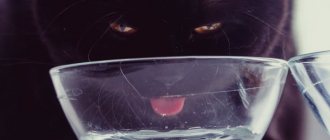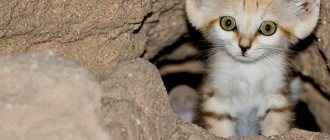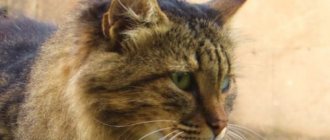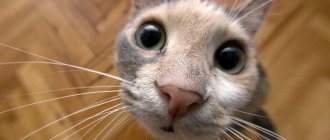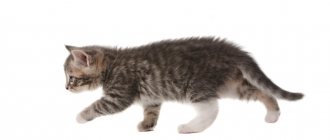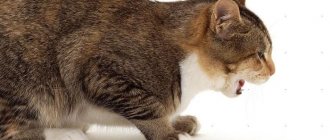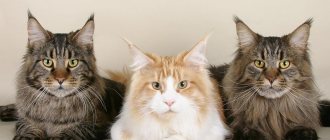A cat's body is 65% fluid. A pet's diet must include not only tasty and high-quality food, but also clean drinking water, which is of great importance for the body. Water takes part in many important life processes and helps dissolve substances entering the digestive tract.
In this article we will look at how to properly give a cat water, how much liquid a cat should be given per day, how to prepare water for drinking, methods for accustoming a cat to water, and answers to popular questions.
How much water should a cat drink per day?
Cats do not need a lot of liquid, but your pet's daily diet must include clean water. Broths and other liquid formulations cannot fully replace regular drinking water. The average daily water intake for a cat is 40-50 ml of liquid per 1 kg of weight.
If a cat eats wet food and eats other nutritious foods well, a certain portion of its daily fluid intake will enter its body. She gets the rest with drinking water. This is why the owner often thinks that the cat does not drink water at all or drinks very little.
Water consumption rate for a pet
There are no general water consumption standards for cats. The amount of liquid your pet drinks during the day depends on a number of factors:
- Body weight of the cat. Veterinarians believe that cats require 20–40 ml of fluid per day per 1 kg of weight. Liquid means not only water, but also milk, broths, and liquid food. However, if the owner thinks that the cat does not drink such a volume, he should not be forced to drink it. Otherwise, the pet will simply be afraid to drink in the presence of the owner.
- Nutrition. An animal that eats a premium food usually drinks less water because the food contains no salt and therefore does not make you thirsty. In addition, owners need to pay attention to the type of food the cat eats. Dry food makes furry pets thirsty, because they literally “pull” fluid from the body. In this case, you will need to set the amount of water you drink and the amount of food you eat in a ratio of 1:3. If the cat eats natural food, you need to reduce the amount of salt added to the food.
- Age. Older cats usually drink much more water than kittens. This is due to the fact that with age, pets begin to eat less and, accordingly, receive less liquid from food, and then replenish the loss of moisture.
- Physical activity. Of course, games, training and long walks contribute to an increased feeling of thirst. This is why more active cats usually drink a lot of water.
- The air temperature in the room where the cat constantly lives. The hot season or prolonged exposure to a room with elevated temperatures always increases the feeling of thirst. This is due to the fact that cats have few sweat glands, so they cannot cool themselves by evaporation of moisture from the surface of the skin. Cats have to lick themselves more often and moisten their fur generously with saliva. As a result of such fluid loss, the pet begins to drink more water than usual.
What kind of water to give your cat
The health and life expectancy of a cat largely depends on the quality of drinking water. The best option for an animal is soft natural water from drinking sources. This water contains beneficial microelements for the body.
Alternatively, you can give your cat filtered or frozen water. Do not give your domestic cat water from the tap. As a rule, it is not of good quality. In addition, it may contain impurities that are dangerous to the cat’s body.
Preparation
The cat is given drinking water in a clean ceramic or glass bowl. The container must be washed daily.
Temperature
Do not give your pet too cold or hot water. The liquid should be at room temperature.
Supplements
Some owners add various additives to their cat’s water to improve the taste or quality of the drinking composition.
Water additives:
- fluorine, iodine (quality improves);
- tuna juice, anchovies (cats are attracted by the smell);
- nettle infusion (for medicinal purposes);
- special nutritional drink for cats.
Diseases accompanied by increased thirst
Increased thirst - polydipsia - often occurs not only for natural reasons, but also as a result of the development of serious diseases. In addition to this symptom, the cat exhibits the following signs of illness:
- loss of appetite;
- the animal rarely or, conversely, goes to the toilet too often;
- the cat becomes weak and inactive.
If your cat begins to drink more water, it is advisable to show it to a doctor to rule out the development of the following diseases:
- Diabetes. With this disease, the pancreas stops producing the required amount of insulin, which delivers glucose to the kidney cells. As a result, they cannot fully filter the liquid; it is eliminated from the body faster, so the cat experiences increased thirst.
- Hepatitis.
- Kidney diseases. In case of chronic renal failure, pyelonephritis, urolithiasis, kidney cells lose their ability to work fully and retain the required amount of moisture in the body, so the cat drinks a lot of water and thus replenishes its reserves.
- Dropsy.
- Inflammation of the pancreas. One of the most common diseases in endocrinology in cats is hyperthyroidism, which is caused by a benign tumor of the pancreas. In addition to polydipsia, there is a sharp weight loss, the pet often goes to the toilet, it has an increased appetite, and nausea and vomiting appear.
- Infectious diseases. If your cat has been diagnosed with any viral infection, you should not limit its drinking. This way the body will cope with the disease faster.
- Intoxication of the body. This condition is usually accompanied by diarrhea and vomiting, causing the cat to lose a huge amount of fluid.
- Stress. Typically, when cats are highly stressed, they drink more water than usual. This is not due to internal diseases, but to psychological factors. In such a situation, it is advisable to limit the amount of liquid your pet drinks.
Answers on questions
Each cat is individual. Some simply drink water without creating any problems for the owner, while other representatives of the feline family are afraid of any liquid and categorically refuse to put their muzzle in a bowl so as not to wet their whiskers.
We have prepared answers to the most common questions that owners of pet cats and cats have.
The cat does not drink water: what to do
A cat's reluctance to drink water may alert the owner.
Insufficient fluid intake leads to dehydration of the body, disrupts the biochemical parameters of the blood, which in turn provokes the development of severe liver and kidney diseases. Before taking measures to correct this situation, you need to determine the reason for the cat’s refusal to drink fluids. Reasons why a cat does not drink water:
- The cat eats wet food. They contain up to 80% liquid, which is quite enough for the animal’s body.
- Reluctance to drink from an uncomfortable bowl. You can try changing the water tank to another one with wider edges, so that it is more convenient for the cat to lap up the water.
- Stale or poor quality water. Cats are very finicky and may refuse to take liquid if it does not meet their needs.
- Serious illness. As a rule, in such cases, the cat refuses not only water, but also food, or consumes it in smaller quantities, without showing much appetite. In this case, the animal needs to be shown to a veterinarian.
Try to find out the reason for the cat's refusal of water. Observe her and if you see that she drinks water from other sources, but categorically refuses to lap up the liquid from her bowl, try replacing it or placing it away from the food bowl. Some cats generally do not drink water if it is next to food.
Special additives that improve the taste and quality of the liquid will also help to accustom your cat to water. Some breeders add a pinch of soda to drinking water or throw an ice cube into a bowl of water. Cats are very curious and may become interested in water if something foreign is floating in it.
If your cat is often outside, there is a high chance that she is getting the amount of fluid she needs from outside sources. These could be ordinary puddles, which, of course, is very unsafe. In this case, the animal can only be retrained by limiting its access to the street for independent walks.
Is it normal for a cat to drink a lot of water?
Excessive water consumption is a clear sign of extreme thirst, which may indicate the development of certain diseases in the cat's body. This symptom is typical for hormonal disorders, diabetes, kidney disease, infectious diseases and febrile conditions.
If your cat drinks a lot of water and there are additional signs of her unhealthy condition, you should immediately take her to a veterinarian, who can determine the exact problem of her unhealthy interest in drinking liquids.
There is no need to worry if a cat that regularly eats dry food drinks a lot of water. With such a diet, the animal must consume a sufficient amount of liquid per day.
Can cats drink sea and salt water?
Cats located far from fresh water can quench their thirst with sea water. Their body filters salt well and removes the unnecessary element naturally. There will be no harm to your cat after drinking salt water, but you should not give it to your cat for daily drinking.
Should I give my cat mineral water?
There are times when a cat accidentally drinks mineral water from its owner’s mug and shows with all its appearance that it quite liked this liquid. Should you give your cat mineral water? Absolutely not, only in the absence of fresh water or for medicinal purposes, as prescribed by a veterinarian. If you regularly give your cat mineral water, urolithiasis may develop.
Should you give your cat boiled water?
Boiled water has a specific taste and, as a rule, cats do not particularly like it. In addition, it is completely useless for the body, so it is not recommended to give such water to a domestic cat. It is better to choose filtered, frozen or bottled water for drinking your pet.
Why does a cat move or overturn the bowl and spill water?
The cat spills water, moves the bowl - what to do? Many animals simply play with water, trying to entertain themselves with something. The reason for this behavior may also be the proximity of the food bowl. Try moving the water container to a different location.
And with this behavior, a cat may indicate the need to change stagnant water to clean and fresh. Change the fluid, not forgetting to rinse the reservoir itself thoroughly.
Watch your cat and learn to recognize her desires! Don't ignore the problem of water refusal or excessive thirst. In any unclear situation, contact your veterinarian.
Why does a cat dig up water?
Magazine “Friend for Cat Lovers” 2020
Cats are mysterious creatures that have lived next to man for millennia, but have never fully revealed all their secrets. The owner of a cat sometimes has no idea how many more amazing secrets are hidden in the mysterious cat’s soul and what unexpected surprises the most ordinary cat can present with its behavior.
One such feature is the unusual desire of cats to dig for water in a bowl, wet their paws there, spill water, or dig near a bowl of water. Surprisingly, this is not such a rare occurrence and there is nothing strange about this behavior.
Cats love to play, and water is one of the most fun toys. There is nothing mysterious about this: the reflections and excitement of the water awaken the hunting instincts in the cat. Cats really like to create waves with their paws, and then watch or even “catch” the play of light on the surface. Sometimes they splash water while playing and there is nothing left in the bowl. If you want to prevent your cat from playing with water, just buy additional toys for her: teasers (you can even use automatic ones if you are away from home for a long time), mice, balls, all kinds of soft toys for cats, etc. Play with your pet often so that he gets tired and does not seek entertainment in the water.
Another reason why cats can splash water with their paw is instinct. The distant (or not so distant) ancestors of our pets drank running water from rivers or streams. They subconsciously understood that running water was the cleanest, healthiest and best. And sometimes this instinct awakens in our domestic cats. In this case, it is best for you to purchase special drinking fountains, they are designed specifically for cats and are equipped with filters that constantly purify the water. The water for your cat will always be clean and served in a form that suits her.
It happens that pet owners live in a very busy rhythm and forget or cannot change the cat’s water often enough. The consequence of this is dirty water, which is not at all to the taste of cats. And, of course, animals try to “unearth” good water. If you are very busy, it is best to purchase an automatic drinking bowl, which needs to be filled with water less often, or the same fountain with a filter for water purification. Cats are very scrupulous about the purity of water. They like to drink only clean water. Perhaps their distant ancestors lived in the forest, where water sources were hidden under leaves, pine needles or small twigs. Then they had to dig down to the water, clearing the surface of a slow stream or even a calm lake. If the water, as it seems to your pet, is dirty or the memory of his ancestors forces him to constantly check the purity of the water and free it from imaginary dirt, then you need to provide your cat with an absolutely clean source for drinking. Here you will also need a fountain, which in appearance is completely different from standing water in a lake or puddle.
It happens that the cat does not like the bowl: it is too deep, and the cat is afraid to put its muzzle in it, because then the cat stops seeing the world around it and it becomes uncomfortable, it feels unprotected. In this case, of course, you can put a smaller bowl of water. However, it should be remembered that in a shallow bowl there is much less water, which means that you will need to place several containers with water and change the water in them much more often.
There is another version of why cats play with water. Perhaps in the wild, their distant ancestors obtained food from water. And this instinct, revived in your pet, forces your pet to “extract” something from the water. The signal for such a “hunt” can be reflections on the water, its slight movement when a cat approaches, or even the reflection of the cat itself. In this case, it is necessary to satisfy your pet’s hunting instincts: purchase toys in the form of fish, mice and other small animals, automatic teasers, tunnels with balls inside, etc. In this case, the cat will be able to “hunt” to its heart’s content and will no longer react so sharply to fluctuations in the water in the bowl. To eliminate such undesirable behavior as “digging” water, you first of all need to understand what lies behind such a desire in your pet. Having determined what exactly is bothering the cat at this moment, it is very easy to solve once and for all the problem with spilling water from the bowl. Sometimes this is the hardest thing. If you find it difficult to immediately answer this question, first try several win-win solutions to the problem: toys, changing the bowl, changing the place where the bowl is, etc.
Your cat is an amazing and mysterious creature. But she can be understood, you just need to learn to observe her, recognize what worries her and what she needs for complete happiness. If you are careful, you will soon not even notice how you will begin to better understand your pet and “speak” the same language with him.
* * * * * * * * * * * * *
Author of the article: felinologist Sokolova Yu. V. Author’s website: psychocats.ru
Attention! When copying an article in full or in part, you must provide an active link to the author’s website.
How kittens learn to drink
How cats drink water is more or less clear. How are things going with the kitten’s fluid absorption? From birth, kittens learn to perform simple actions. Their mother helps them with this. Babies may not lap like adults right away either. If you watch a kitten drink water, you will notice that at first it only pokes its muzzle into the bowl and swallows the liquid with its mouth.
Due to the absorption of liquid in this way, water gets into the kittens' nose. Therefore, children often sneeze after drinking. Kittens learn to drink water correctly by watching their mother cat.
But sometimes it happens that small animals for some reason are left without a mother. In such situations, a person often takes care of newborn babies. Kittens are first bottle fed, after which they learn to drink from a bowl on their own.
Such animals often drink differently than their relatives. They simply lower their mouth, open their lower jaw, and then make a swallowing movement. Of course, in this case it is difficult to avoid getting your fur coat wet.
How do cats drink?
There are probably few people who have never seen a cat drink. And many of them wondered how exactly she does it. In this regard, everything is clear with a person - he simply sucks in water.
By the way, many other animals do the same - sheep, cows, not to mention our closest relatives. Dogs act differently - they use their tongue, which turns into a spoon, to drink.
Cats behave completely differently. Once again imagine a dog bowl - water splashes, the face is all wet. Cats, on the other hand, go to the watering hole delicately, lap it carefully, and remain clean and dry. Just perfect thieves - as soon as they turn away, the creamy thief can be identified only by his satisfied face.
As early as 1940, Harold Edgerton of the Massachusetts Institute of Technology was studying drinking habits in cats. His innovation was the use of stroboscopic photography. Then it was possible to establish only the “wrong” bend of the tongue, not forward with a spoon, but backward.
Edgerton's work was continued by Roman Stoker from the same institute and his colleagues. The scientist was prompted to take this step by observing his own cat. Roman recorded the process on video and then watched the recordings in very slow motion (up to 67 times). And the results were stunning. To begin with, there was an opinion that hairs on cat tongues were necessary specifically for lapping. Research has proven that this is not the case. The mechanism is completely different from all other drinking methods.
The cat only lightly touches the liquid with its tongue and only the surface itself. Some of the water sticks to the tongue due to adhesion. This is followed by a rapid movement of the tongue, as a result of which the water is carried along with the tongue and begins to rise, forming a column. Moreover, the process of formation of this column is nonlinear - first the volume of the water column increases, then a certain maximum is reached, and then the column becomes depleted and falls.
At the moment of the greatest completeness of the column, the cat quickly closes its jaws, as if biting off the upper part of the column. It’s simply amazing how exactly such a nutritional mechanism could arise. Moreover, a very delicate balance is required in determining the moment of “biting off”: a little earlier or later and the animal will get a significantly smaller amount of liquid.
It is assumed that the reason for this interesting behavior was the special sensitivity of cats’ whiskers located on the face and their dislike of getting wet. What’s also interesting is that this method is typical for all felines. This was verified by scientists using videos of big cats (lions, tigers, leopards). Based on the developed mathematical model, a robot-lacker was created. It has also been shown that the frequency of lapping is inversely proportional to the size of the cat and tongue, respectively.
Cats can drink sea water
The human body is not able to use sea water for drinking; too high a salt content leads to rapid dehydration. The kidneys in cats work differently, and are able to filter salt from sea water and maintain the required level of hydration - why and how exactly this mechanism was formed in the process of evolution is not completely clear.
What to do if your cat drinks a lot of water
If the owner notices that the cat drinks water too often, you first need to observe his behavior, because increased thirst can be caused by natural reasons. If your pet develops other alarming symptoms that indicate the development of any disease, it is recommended to visit a veterinarian as soon as possible.
The doctor will examine the animal and, if necessary, prescribe the following diagnostic tests:
- glucose monitoring;
- general and biochemical blood test;
- general urine analysis;
- Ultrasound and CT scan of the abdominal organs.
Based on the test results, the veterinarian will select treatment and, in some cases, prescribe a special diet.
A responsible owner should notice the slightest changes in the behavior of his cat. If your pet begins to drink a lot of water, and adjusting its lifestyle has no effect on the situation, it is better to show the animal to a veterinarian. After all, increased thirst can be one of the symptoms of a serious disease that threatens the life and health of a pet.

